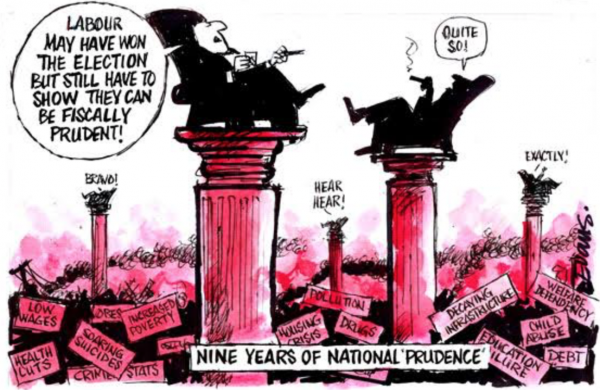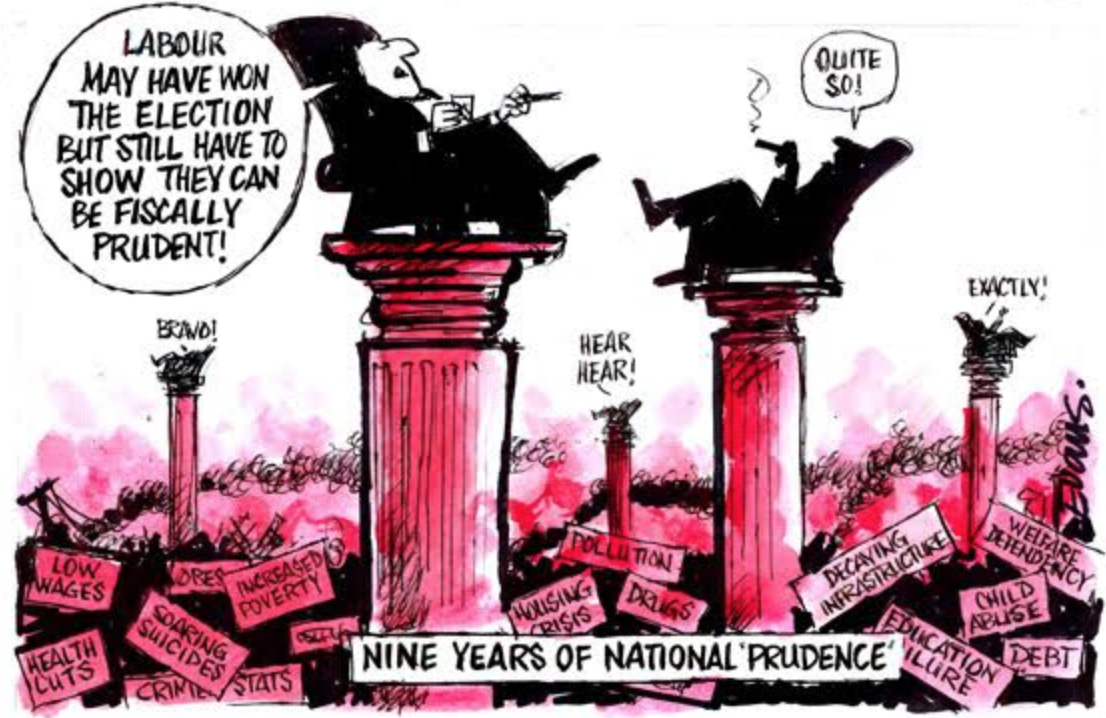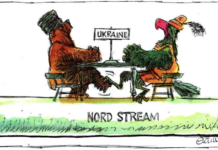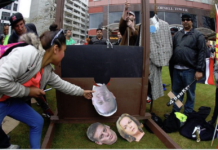
Bosses and their paid servants in the so-called economics “profession” are already screaming about the proposed minimum wage hike in New Zealand to $20 an hour by April 2021.
Most of their objections amount to the repetition of dogma which they want us to believe is some sort of science. Usually, very few facts are ever advanced to support their views.
Branko Marcetic writing on Spinoff website has done a good refutation of the arguments against minimum wage rises by drawing on the international evidence, including real examples from the U.S. I want to look at what actually happened in New Zealand when we had a similar percentage minimum wage rise over a similar period, from 2004 to 2008. As unwelcome as they are to right-wing dogmatists, let’s look at some facts.
Labour was elected in 1999 with the adult minimum wage at $7 per hour and a youth rate of $4.20 per hour applying to those under 20. There were some modest increases for the next few years and the youth rate age of eligibility reduced to apply only to those under 18.
In 2004, the adult rate was $9 per hour and the youth rate $7.20. This was increased to $12 and $9.60 over the next four years – an increase of 33 per cent. Inflation during that period was 12.5 per cent, so there was an increase in the real value of the minimum wage. There was also an increase in its relative value: rising from 45.4 per cent to 50.6 per cent of the average wage. When it reached this level, then-Prime Minister Helen Clarke said she was “comfortable” with the level reached and would seek to maintain it at that level rather than increase it.
The National Party was elected in 2008 and it has largely kept the minimum wage at its 2008 level, relative to the average wage, though by April 2017 there was a small increase to 52.7 per cent of the average wage.
The previous National government had not increased the minimum wage once (except for one year in 1996 when Winston Peters was in coalition with them). When it was elected in 2008, we did not know what this National government was going to do. In fact, they chose to increase it each year. There was even some grumbling behind the scenes from some bosses friendly to the party.
During the election campaign in 2008, Unite Union launched a campaign for an immediate lift of the minimum wage from $12 to $15 an hour. When National won office, they faced a massive public education campaign and petition. We collected 200,000 signatures! We had stalls, banners, speakouts at every festival, sports games and community events over the course of the year following.
Opinion polls showed two out of three people supported us. We were front page news in daily newspapers.
I don’t know if Unite’s campaign was necessary or not to make National continue with annual minimum wage increases. But I am absolutely sure that the size of the increases were bigger than would have been the case without the campaign. At the very least, the value of the minimum wage would have fallen rather than risen.
The agreement to lift the level to $20 by April 2021 will increase the adult rate from $15.75 to $20 an hour over four years. That is an increase of 27 per cent – a bit less than the 33 per cent increase from 2004 to 2008. The right-wing commentators at that time predicted doom and were proved wrong.
Here are some other economic statistics for the same period – April 2004 to April 2008.
- The unemployment rate declined from 4.7 per cent to 4.2 per cent.
- The Labour force participation rate increased from 66.7 per cent to 67.7 per cent
- Youth unemployment and participation rates were almost unchanged.
- Inflation averaged 3 per cent a year while the minimum wage increase averaged over 8 per cent a year.
Some of the biggest increases in the minimum wage have occurred for young workers. In 2001, 18- and 19-year-olds were put on the adult rate. By 2005 their rate had more than doubled from $4.55 an hour to $9.50 an hour.
Were young people priced out of the labour market as the dogmatists assured us would happen? No, in fact, the opposite happened. Employment for this group increased overall and unemployment dropped.
According to the Household Labour Force Survey, during that period from the March quarter 2001 to the March quarter 2005, employment of 15-19-year-olds increased from 120,600 to 140,600; unemployment declined from 26,300 to 23,800 and the unemployment rate declined from 18.7 percent to 14.5 percent. The overall labour force participation rate for 15-19-year-olds increased from 51.2 to 54.3 percent. Right-wing commentators at the time simply changed course and argued that the minimum wage was too high for young people because it was encouraging them to go and get jobs!
These facts will not prevent dogmatists like those who write for the extreme right-wing economic think tanks and commentators from predicting more doom and gloom. The New Zealand Initiative is the most prominent think tank in New Zealand advocating these views.
The economic principles these groups espouse derive from a fundamentalist brand of economic thought that actually opposes any minimum wage as an interference with the free market. The free market, in their view of the world, has an extraordinary ability to only deliver positive outcomes at all times – so long as we don’t interfere. The Act Party is their ideological advocate in parliament.
This is a religion and not a science. Their views should be treated with the same respect that is given to Brian Tamaki’s views on sexuality – they are nothing but ignorant bigots. The economists only differ from Brian Tamaki because they have a degree conferred on them by other ignorant bigots who run the academic economics “profession” worldwide.
When the media report their comments it should come with a health warning: “The New Zealand Institute does not use facts to support their argument – they appeal a god called ‘the market’ to justify their views.”
Take a look at this rather typical article by the New Zealand Initiatives’s Roger Partridge in the National Business Review attacking the planned minimum wage hike headed ‘Magical thinking doesn’t lift wages‘. “It is magical thinking to believe that we can make the poor better off by simply legislating substantial increases in the minimum wage.” Really? What about 2004-2008 in New Zealand? The writer does not need to point to a real-life example. His proof comes next: “Labour markets work like other markets. Put up the price and demand will decrease.” That is not proof. That is dogma!
Roger Partridge then quotes another dogmatist from his own institute for further proof in the form of the NZ Initiative’s Eric Crampton. He doesn’t actually quote any facts, either; he simply quotes the estimates done by the Ministry of Business, Innovation and Employment, the government ministry responsible for preparing reports over possible economic impacts of minimum wage rises. The problem with the MBIE estimates is that they are done by economists trained in the same religious dogma; consequently, they predict automatic increases in unemployment for each additional increase in the minimum wage.
Here is a typical MBIE comment which I cite in an earlier discussion of minimum wage rises entitled ‘Exposing right-wing lies’:
“The estimates of constraint on job growth are based on a neo-classical model of firm decision-making, whereby firms operating in perfectly competitive markets adjust output and inputs, including labour, in response to relative prices. This modelling approach does not adequately reflect the dynamic nature of employment responses to changes in minimum wages, and, in particular, any investments that employers may make to increase the productivity of low paid workers. One consideration for the impact on the demand for low wage workers is how minimum wages change relative to average wages. If minimum wages keep pace with average wages then we would expect to see little change in the relative demand for low wage workers or low wage jobs.”
As I commented then: “Instead of using a model for an economy that does not exist, we can use the actual changes that have occurred in New Zealand.”
The problem is that the “neo-classical model” has blown up all over the world and not even major institutions that have defended it for decades even pretend to believe in it anymore. However, the minimum wage rise being proposed is a significant increase and will continue to meet strong opposition. Any increase in unemployment will be blamed on the minimum wage. The continuing problems around youth employment will be blamed on the planned abolition of a separate lower youth or training rate.
The union movement, in particular, needs to continue to campaign to make the minimum wage a living wage. We must win the economic arguments and debunk the fear-mongers.
New Zealand already has one of the highest minimum wages relative to the average wage in the OECD – the club of the most advanced capitalist countries. Yet we actually have one of the lowest official unemployment rates. We have pushed further in the past on the minimum wage; for example, in the early to mid-1970s under a previous Labour-led government, the minimum wage was 66 per cent of the average wage.
Reaching $20 an hour by April 1921 will actually take us much closer to our goal of a living wage equal to the living wage, which is around 66 per cent of the average wage.
That is why it is dangerous for some left-wing commentators to simply dismiss the increases planned as being of no significance. An example of this is my friend Daphna Whitmore on Redline. She dismisses the minimum wage rise as “not a seismic shift”. She continues, “The minimum wage has risen every year for over a decade, mostly pushed by union and community campaigns for a living wage. Despite talk of the new coalition [government] being a ‘change government’, the Labour [Party]-led team will have boosted the lowest-paid workers a mere 25 cents an hour more than the National government likely would have. The living wage remains, as ever, postponed. If by 2021 the minimum wage is $20 an hour, it is unlikely to be a living wage with costs rising in the interim.”
In my view, the constant repetition of a ‘glass half full’ analysis is not actually useful. Facts are useful sometimes – even for left-wing commentators.
The minimum wage has actually been increased every year for 18 years. The increases have taken it from 40 per cent of the average wage to 53 per cent today. This was a victory for campaigns like those run by the Unite Union and others.
By 2021, I estimate that the minimum wage will have gone from 53 per cent of the average wage to 61.5 per cent of the average wage, after allowing for average wage movement over the next four years similar to what has occurred over the last four.
Rather than “postponing” the living wage, this will bring us within sight. The living wage calculation today is approximately 66 per cent of the average wage. It is being implemented immediately by the new government for all directly-employed staff and then for contractors to the government in the future. This is also significant. It is not being “postponed”.
Because it is a significant change that will make a real difference in the lives of hundreds of thousands of workers, this will continue to be a contested area for the class struggle. Ignorance won’t help our side win.






Kim Campbell (EMA) when asked on the Nation, what he thought about raising the minimum wage to $18.50 and hour stated ” why not make it $20 or $30 why stop there” His argument being that it was going to cost lobs and close businesses down. Clear scaremongering.
But to use his analogy and Nationals 90 day working trial, why not make it 300 days or 500 days working trial or Keys increase to 15% GST, why not make it 20% or 30%
Kim Campbell is a self interesting egomaniac right wing scaremongering buffoon. His intellect is minimal though as he cannot see that people see straight through his diatribe.
What he fails to realise are the benefits of raising the minimum wage. Regeneration of incomes resulting to increased spending in business, generating more jobs and creating an even stronger economy. But then again Kim is a doomsday merchant looking at a glass half full scenario.
Yep. Kim Campbell is a “Class A” dickhead. He’s always the first to claim that we need to pay astronomical multi-million dollar salaries to CEO’s because NZ companies are competing for “management talent” in a global marketplace.
Whenever anyone suggests raising the minimum wage so regular workers can afford to live with some dignity he raves about companies going broke, unemployment going through the roof and the economy tanking into recession. All of which is completely unsubstantiated, scaremongering bullshit.
Ok. I’ll start it off… Well said.
The new Minister of Employment, Willie Jackson is on his own now as there is no Min. of Industrial relations!? Will this be a positive move for progress in the recovery of workers rights & condition and if so, how fast or slow will changes come?
The minimum wage booster is one of the best things that could happen to this country. The extra money will lead to a boon for business (especially local). It will redistribute profits to wages and reduce inequality.
One of the points I made in my article quoted was that Labour was not offering something substantially different to National. Mike doesn’t refute the difference between what National was likely to do in April 2018 is 25c an hour with the new government’s minimum wage rise to $16.50. A living wage is $20.20 in 2017. In 2015 a living wage was $19.25. In 2021 $20 an hour will still not be a living wage – unless there is deflation. That doesn’t look likely.
The business sector have made noises about the rise but they accept it as they have every year, for the past 18 years. Michael Barnett when he was on Q & A said he was not concerned as the increase had long been signalled. He was also taking heart from the government talking about tax breaks to small business. Small businesses are worried about increasing pay rates, but they will probably get concessions from this government.
What was more central to my article was the idea that we should think of workers as a class globally, rather than nationally. What meaning does a living wage have if it only applies to wealthy nations and we ignore the 80% of the working class who live in the third world? Especially as this is where so many of the goods we consume are produced in a thoroughly globalised world.
An outward looking working class is much more likely to build solidarity with migrant workers, with Manus Island asylum seekers and Bangladeshi garment workers.
ok, ok … my 2 cents worth (maybe 3).
First off, those protesting against increasing the minimum wage certainly aren’t polymaths. More often than not those earning minimum wage are renters and employers are often landlords. A simple food and rent hike would craw back most of these wage increases.
I think these employers are being awfully harsh …
… to their paid ‘servants’!? Honestly, wage earners in NZ are often more akin to slaves. Slave owners were at least expected to provide food, clothing and shelter – sometimes slaves in various cultures received equity in the master’s asset base after approximately a decade of servitude or their masters death.
NZ’s modern day slaves (wage earners) do a full weeks work, sometimes working multiple jobs to afford to live. When I say ‘afford to live’, wage earners pay 100% of their earnings on housing, food, power and work necessities (phone, transport). Wage earners can’t even afford the luxury of insurances (car, contents, medical).
The truth is innovation and the talents of a couple of generations have been squandered. Covetousness (the inability to be content without something) and Greed (more than what is fair or necessary) has griped many wealthy Kiwis causing a madness to ensue, where in their hearts they say, “I’ll never know want, no misfortune can stop ME, I’m too smart!”
Wage earners don’t have anything left to be extracted from them, except for perhaps their Kiwi Savers. But don’t underestimate Mr Greed, to keep profits up companies have just imported more slaves from overseas …
We are now entering the end game, Kiwi’s are tapping out. It’s true many are forced out to the streets, it’s also true people are choosing to live in tents, campers and even cars rather than paying outrageous rents. Foreign workers are now even looking at higher paying jobs overseas!
We are now post The Great Hollowing out of NZ. At verbose claim perhaps, but like the frog unwittingly being boiled alive, the results are real.
Predictions, well quickly …
1. The housing crisis with grow and paradoxically starting next year it will be harder for landlords to secure a tenant.
2. International media will turn on NZ as a desirable place to live and work
3. An Australian banking crisis will cause liquidity in NZ to dry up resulting in a cannibalization of the rich, via the wealthy.
4. Millennials with continue slowly building their cypherpunk economy.
It is not raising the minimum wage that will hurt businesses. It is the increasing amount of red tape, superfluous work safety and other complications that hurt them, particularly small businesses who can’t afford an army of accountants and personnel officers to sort it out. One thing the new Labour government would make businesses very grateful for is to reduce the b..s and compliance costs. This done, I think many of them would not grumble so much about paying workers more.
Comments are closed.